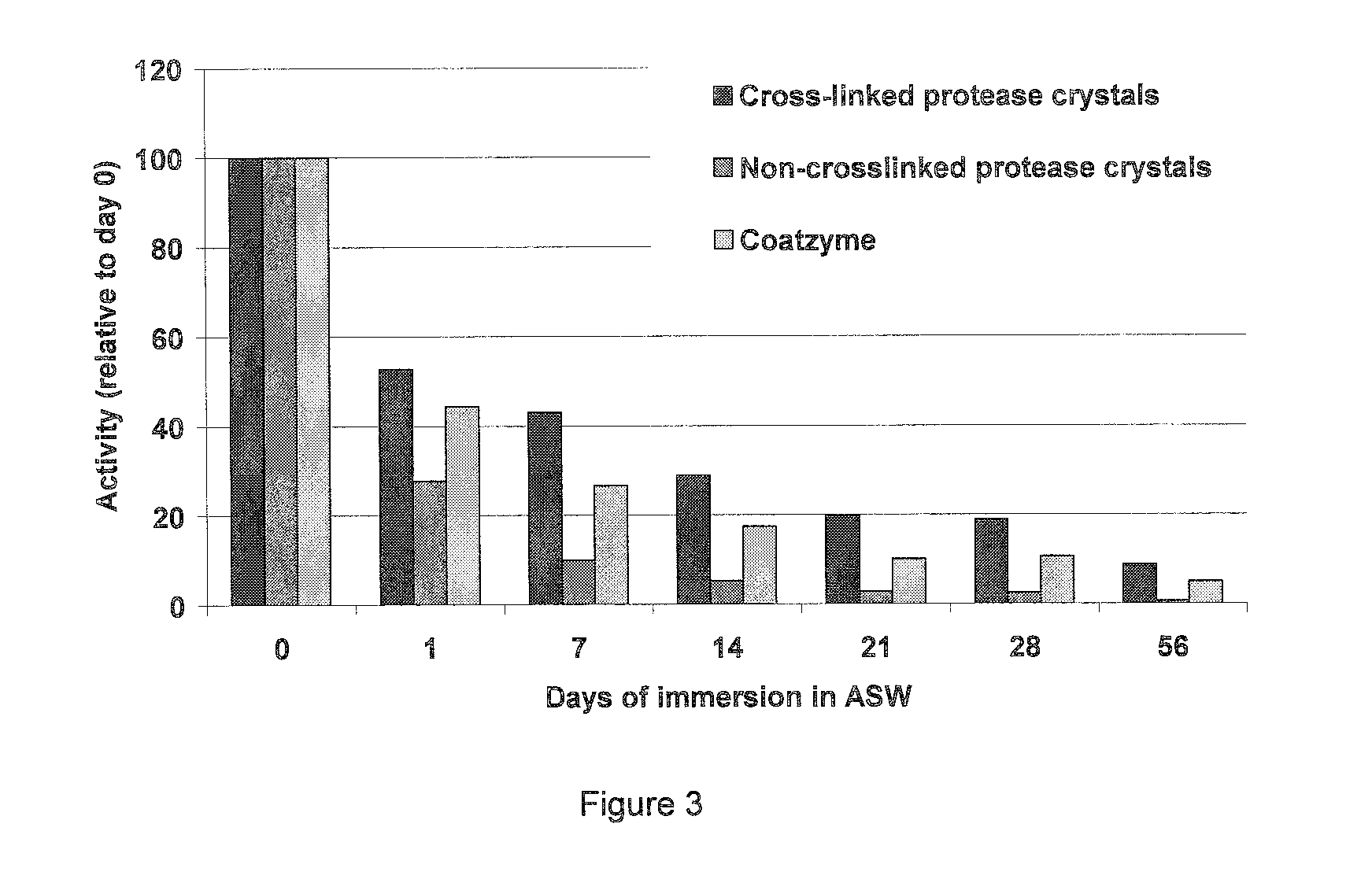Composition
a technology of composition and antifouling, applied in the field of composition, can solve the problems of biofouling, hygienic and functional problems, and particular type of biofouling
- Summary
- Abstract
- Description
- Claims
- Application Information
AI Technical Summary
Benefits of technology
Problems solved by technology
Method used
Image
Examples
example 1
Preparation of Protease Crystals
[0282]Crystals of a subtilisin protease with the sequence shown in SEQ ID NO 1 was prepared. The subtilisin is derived from Bacillus amyloliquefaciens and may be prepared as described in U.S. Pat. No. 5,441,882.
[0283]The aqueous solution which acts as starting material for the method is derived from the fermentation broth produced by the fermentation of an appropriate microorganism. The fermentation procedures for culturing cells and for production of protein are known per se in the art.
[0284]Ultra-filtration of the cell free broth was carried out with a polysulfone membrane having a 10 kDa molecular weight cut off in a spiral ultra-filtration unit to provide the ultra filtrate concentrate (UFC). The resultant protease solution was at a concentration of about 100 g / L of active enzyme. The protease concentration can be determined by the method described in Estell et al. (1985) J. Biol. Chem. 260:6518-6521.
[0285]The protease containing UFC was mixed wit...
example 2
Preparation of CLECs (Cross-Linked Enzyme Crystals)
[0286]Protease crystals were cross-linked with glutaraldehyde to provide solid particles that are insoluble in an aqueous system. Glutaraldehyde was added to the protease crystals obtained in example 1 to a final concentration of 1% (vol) of the paste and incubated with gentle stirring for 3 hours at 4° C. After this the solution was freeze dried and the obtained material crushed in a mortar to obtain a dry powder with a fine particle size suitable for the paint application.
example 3
In-Paint Activity of CLECs
[0287]Protease crystals were added to 4% (w / v) of a commercial antifouling paint (Mille Light from Hempel A / S) both in the cross-linked and non-cross-linked form. The resulting paint was applied in triplicate and for each replica in two layers at the inside of 6-well polystyrene tissue culture plates. The paint was then allowed to dry for three days at room temperature. Further, a commercial protease containing paint, Coatzyme obtained from BioLocus NS, Denmark was included in the assay for benchmarking.
[0288]The plates were immersed in large excess of artificial sea water (ASW)(NaCl: 24.0 g / L, MgCl2 5.1 g / L, Na2SO4 4.0 g / L, CaCl2 1.1 g / L, KCl 0.67 g / L, KBr 0.098 g / L, H3BO3 0.027 g / L, SrCl2 0.024 g / L, NaF 0.003 g / L, NaHCO3 0.196 g / L). At regular intervals the plates were taken out of the ASW and the protease activity assayed (FIG. 3) before the plates were immersed in a fresh batch of ASW. The protease assay was based on the ability of a protease to cleave ...
PUM
| Property | Measurement | Unit |
|---|---|---|
| acid value | aaaaa | aaaaa |
| acid value | aaaaa | aaaaa |
| acid value | aaaaa | aaaaa |
Abstract
Description
Claims
Application Information
 Login to View More
Login to View More - R&D
- Intellectual Property
- Life Sciences
- Materials
- Tech Scout
- Unparalleled Data Quality
- Higher Quality Content
- 60% Fewer Hallucinations
Browse by: Latest US Patents, China's latest patents, Technical Efficacy Thesaurus, Application Domain, Technology Topic, Popular Technical Reports.
© 2025 PatSnap. All rights reserved.Legal|Privacy policy|Modern Slavery Act Transparency Statement|Sitemap|About US| Contact US: help@patsnap.com



